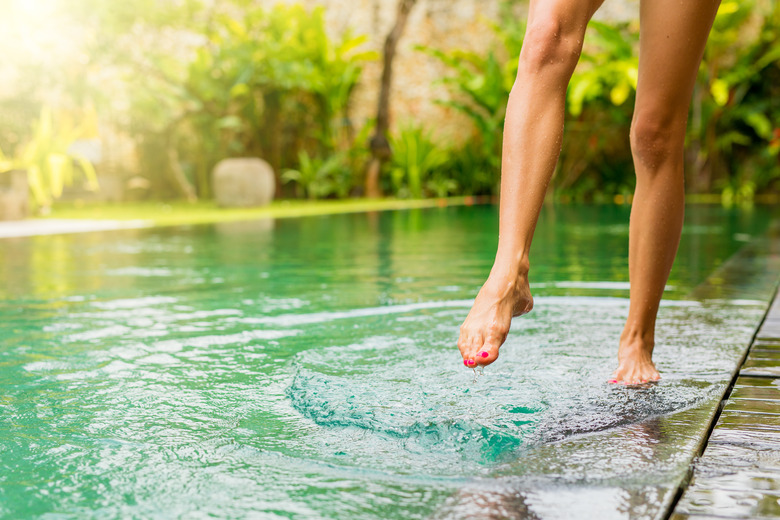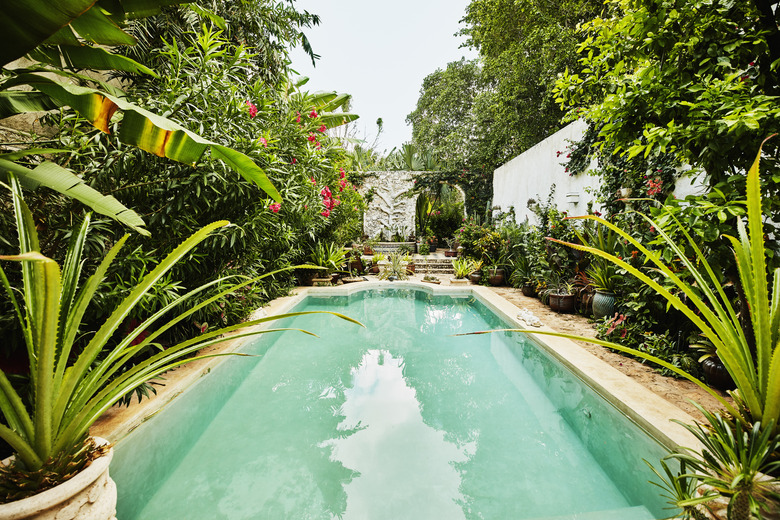Natural Swimming Pool Types And Designs
We may receive a commission on purchases made from links.
You might get on the natural swimming pool bandwagon because you love the thought of swimming in chlorine-free water, but the benefits a natural swimming pool will confer on your landscaping are just as important. Unlike a conventional pool, which functions as an isolated unit, a natural swimming pool has a symbiotic relationship with its surroundings, providing a haven for plant and insect life which in turn filter and purify the water. There's lots of room for creativity because no single swimming pool design is suitable for every circumstance.
Unlike traditional swimming pools, which are full of sanitizing chemicals, natural pools have two separate zones, one for swimming and one for purifying the water, and the latter, also known as the regeneration zone, has much in common with outdoor water gardens. Depending on how you design the pool, the regeneration zone needs to occupy 30 to 50 percent of the pool area to perform its function, and rather than being a limitation, that's an opportunity to flex your landscape design muscles.
Standard and Optional Design Features
Standard and Optional Design Features
Just as trees grow in every shape imaginable while each having the same components — namely a trunk, branches, roots and foliage — a natural swimming pool has no standard shape, but it does have distinguishing components. It has a swimming area — or it wouldn't be a swimming pool — and it has plant life, which can be scattered throughout the pool or confined to a particular area of the pool. The entire pool should be at least 500 square feet in area to prevent runaway algae growth, and it needs an impermeable liner and some means to circulate the water to keep it oxygenated and maintain the health of the pool's biological filtration system.
Now for the fun part: No rule dictates the shape of the pool or its depth, the edging or liner materials or the layout of the surrounding landscape. Some plants work better than others for water filtration, but you still have a lot of latitude in choosing them, and you can also include fish in your pool if you're so inclined. You can create a setting reminiscent of a mountain stream, convert your existing swimming pool into a natural swimming pool for the kids or turn your whole backyard into a water garden with atmospheric lighting for midnight bathing.
The French Natural Swimming Pool Design
The French Natural Swimming Pool Design
The concept of natural swimming pools originated in Austria in the 1980s, and the Europeans have been developing it ever since. One swimming pool design that comes from France and has become popular in other countries resembles a conventional rectangular pool but with a key difference. The pool is bordered on one side and one end by a standard pool curb, but the other side and end form a shoreline with the surrounding terrain, thus creating a natural growing zone for wetland and aquatic plants.
The shoreline transitions to a shallow gravel bed that is covered by a foot or so of water, making an ideal growing environment for beneficial algae, which together with the rest of the plants in that part of the pool form the filtration system for the water. The gravel bed terminates abruptly, establishing an underwater wall that defines the edge of the swimming area. Approached from one side, this natural swimming pool looks like any other pool, with ladders and built-in pool filters to remove large debris, but from the other side, it's a pond teeming with wildlife.
This is an example of an eco-friendly integrated swimming pool design in which the swimming zone and regeneration zone aren't clearly separated. As a variation, you could design a pool with irregular edges, like a pond, with an underground barrier that surrounds the entire swimming area. On the outside of the barrier, plants and algae grow in fairly shallow water, but inside the barrier, the water is much deeper, which helps discourage runaway algae growth in the swimming pond.
Pools With Clearly Defined Zones
Pools With Clearly Defined Zones
Sometimes, it makes sense to separate the swimming and regeneration zones by a retaining wall or some other barrier and circulate the water between them. The pool can take the familiar rectangular shape of a chlorine pool, or it can have curved edges bordered by natural stone, while the regeneration zone is completely dedicated to plant life. Water circulates between the two zones through apertures in the pool walls where mesh filters are placed to remove debris, or it can be naturally aerated by falling over rock walls. The success of this design depends on constant circulation of the water, and because you usually accomplish this with a pump, it's more energy intensive than an integrated design.
A two-tiered design is a particularly creative way to take advantage of all that water can offer your backyard landscape. Plants grow in the upper tier, which is ideally at the same level as the rest of the landscape to make the plants easily accessible for maintenance, and the swimming area is on the lower tier. A pump in the pool circulates water to the upper tier, where it circulates among the plants and spills over the rocks, filling the air with negative ions and the soothing sound of a waterfall. Because this swimming pool design depends more on continuous pumping than a French pool, maintenance costs will tend to be higher.
A DIY Water Garden Retreat
A DIY Water Garden Retreat
The success of a natural filtration system depends on making the pool as large as possible to discourage beneficial algae from growing close together and clumping, so in many ways, it makes sense to devote your entire backyard — or as much of it as possible — to your natural swimming pool. The pool can slope gradually from the boundaries of the property, where semiaquatic plants establish a transition to clusters of water lilies and other floating species.
The swimming area is bordered by an underwater barrier, and a wooden or stone walkway provides access to it. The walkway can lead to a deck or sitting area where you can enjoy the dragonflies and frogs between dips in the pool area, and low-voltage landscape lighting helps create an atmospheric spot for entertaining guests or for quiet contemplation at night. Think Oriental water garden and you get the idea.
The more generous you are with your allotment of space, the more features you can introduce into your natural swimming pool and surrounding water garden. You might install one or more fountains to help aerate the water, and if you use inexpensive solar fountain pumps, they will come on automatically when the sun is out, which is when aeration is needed the most, without adding to your maintenance costs. You can also build rock features and use solar pumps to create waterfalls. These pumps are in addition to the ones you need to circulate water throughout the pool system, which must operate 24 hours a day and shouldn't be solar powered.
Converting an Existing Chlorine Pool
Converting an Existing Chlorine Pool
It is possible to convert a conventional pool into a natural swimming pool, but it isn't easy, and one reason is that the equipment you need is different. Rather than a powerful pump designed to circulate chlorinated water, you need a more gentle circulation system that feeds water through a living biofilter and aerates it, so all the underground pipes that connect the pool pump, which is often in a separate housing, have to be repurposed or scuttled. Apart from that, there are logistical difficulties associated with incorporating a water garden into an existing pool.
The most realistic way to make the conversion is usually to rip out the old pool and use the hole in the ground as your starting point for a living pool. That's an expensive proposition, and you may want to save your old pool, especially if it's a designer model in good condition. In that case, you might want to go with a converter system, such as the Biotop Living Pool system, which consists of an electric biological filter that you install in a separate compartment next to the existing pool. If you really want to go the distance and turn your backyard pool into a natural swimming hole, however, you basically have three options.
The first is to partition the pool into equal sections and devote one to the filter garden. Plants tend to grow best in shallow water, so you'll probably want to partially fill that section with sand, gravel or some other substrate. A second option is to dig out areas around the pool in which to plant water gardens and connect them to the main pool in such a way that water can flow freely. Considering that the total area of the water garden must be the same as the pool area, that could claim a lot of backyard space and will probably involve a lot of digging. If you don't mind losing the space but the thought of that much digging doesn't excite you, there's a third option, and it may be the best of all.
Let the Pool Take Over Your Yard
Let the Pool Take Over Your Yard
If your backyard is flat and you have an in-ground pool, you have an ideal setup for an integrated natural swimming pool. All you need to do is build a 2- to 3-foot waterproof retaining wall around the pool that encloses an area roughly equal to twice that of the pool itself, line the ground with a black plastic pond liner and fill in the area with water. The original pool is now surrounded by a shallower one in which you can introduce the vegetation needed to purify the water.
The walls of your enclosure can be straight, or they can meander along the contours of the landscape, following existing walkways or wending their way along the edges of garden beds. You can build walkways inside the pond enclosure to give you access to the pool area, which by virtue of its depth should remain full of crystal-clear water. You can even build a deck around the existing pool to better define the swimming area and use it for lounging and for a base for performing your maintenance tasks.
You'll probably have less maintenance to perform than you would if you dug a hole and lined it with plastic. The existing pool finish, whether it's gunite, tile or fiberglass, is easier to vacuum, and all the debris that falls into the pool and sinks to the bottom will be easier to spot. You can even use the existing pool lights to illuminate the swimming area at night, and the light may diffuse through the rest of the water garden, creating a languidly relaxing nighttime gathering spot.

